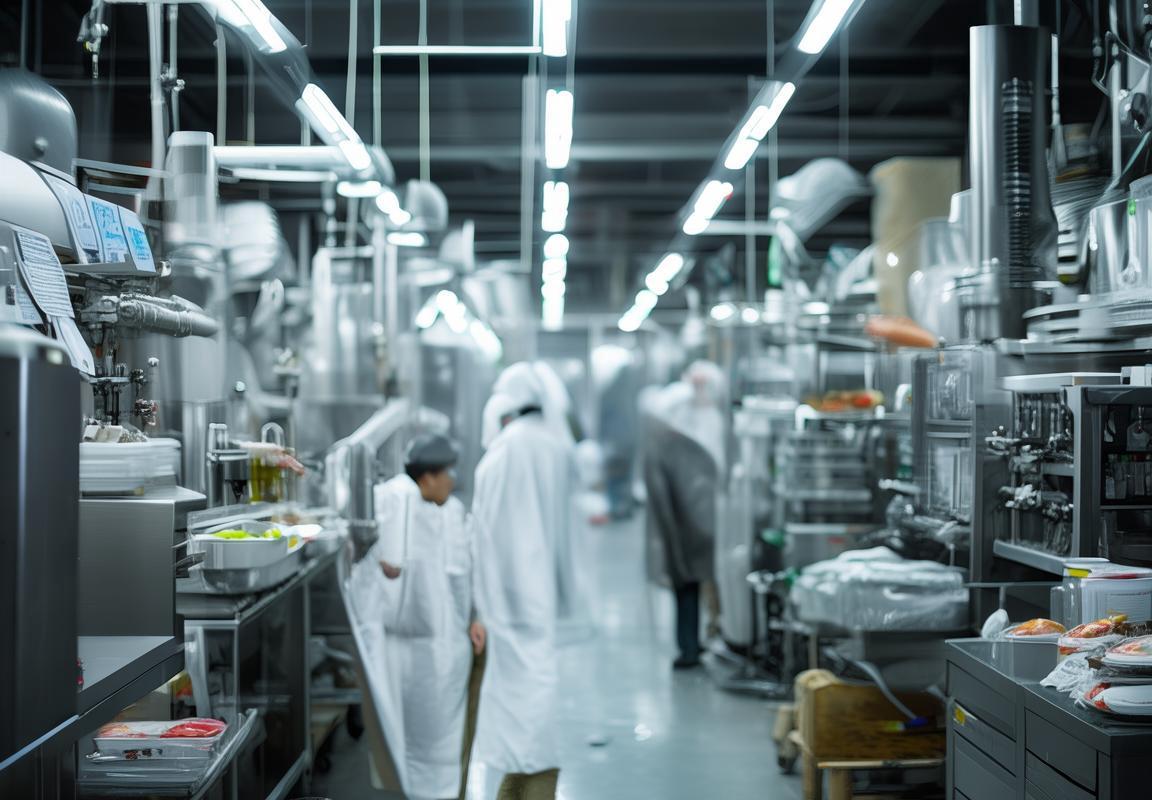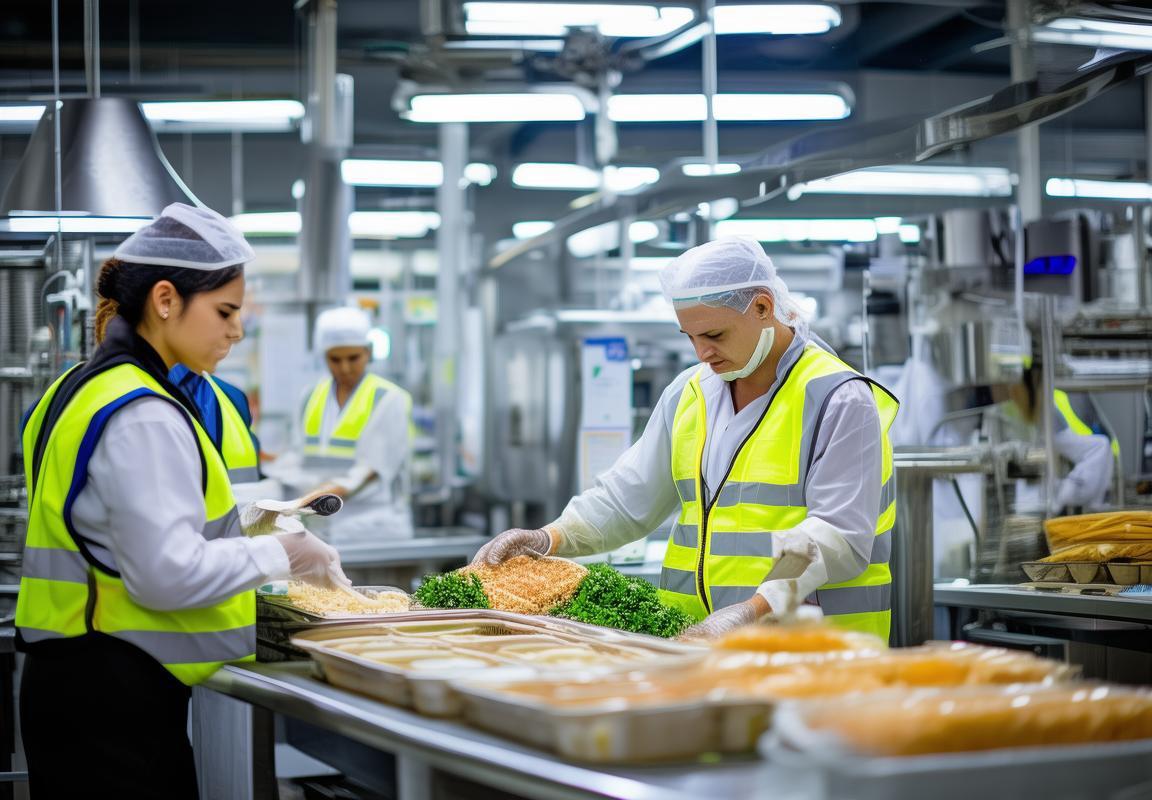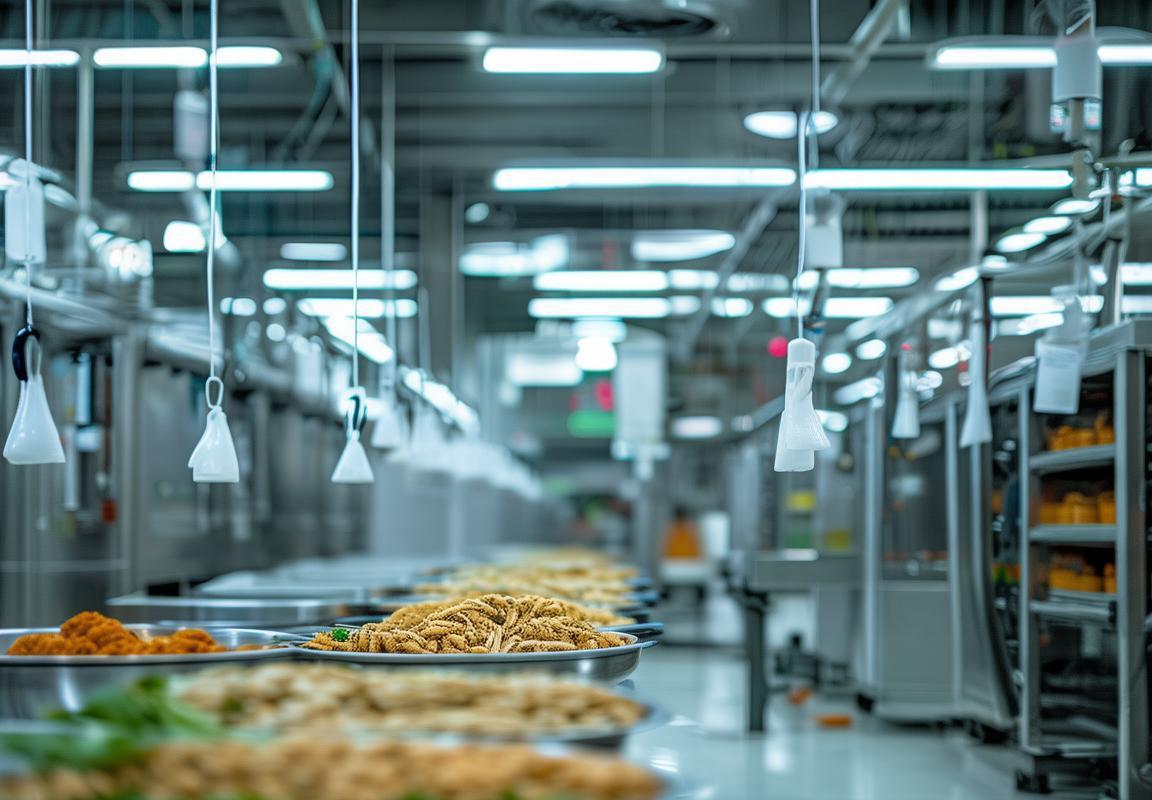Navigating the complex world of food safety in a factory setting is no small feat. With countless regulations and standards to adhere to, ensuring that your production environment is both safe and compliant can be daunting. One such standard that stands out for its rigorous approach to food safety is ISO 22000. In this article, we delve into the intricacies of this certification, exploring its key components, the benefits it brings to your factory, and how it can enhance customer trust and marketability. We also share a real-life case study to illustrate the successful implementation of ISO 22000, discuss the challenges faced in maintaining compliance, and glimpse into the future of food safety standards in your factory. Ultimately, we hope to provide you with the insights needed to embrace ISO 22000 and foster a safer food production environment.
Understanding ISO 22000: The Gold Standard for Food Safety
ISO 22000: The Gold Standard for Food Safety
In the world of food production, where the stakes are high and the consumer’s trust is paramount, ISO 22000 stands as a beacon of excellence and a gold standard for food safety management. This international standard is not just a set of guidelines; it’s a comprehensive framework designed to ensure that food is safe from farm to fork. Let’s delve into what makes ISO 22000 so crucial in the food safety factory landscape.
At its core, ISO 22000 is a certification that focuses on the entire food chain, encompassing all organizations involved in the production, processing, and handling of food. It’s not just about the final product; it’s about the entire process, from the sourcing of raw materials to the delivery of the finished goods. This holistic approach is what sets it apart from other food safety standards.
One of the key aspects of ISO 22000 is its emphasis on preventive measures. Instead of merely reacting to food safety issues, this standard encourages organizations to proactively identify potential hazards and implement systems to prevent them. This proactive stance is essential in a factory setting where even the smallest oversight can lead to contamination and recall.
The standard is built upon seven principles that guide food safety management. These principles include the identification of food safety hazards, the establishment of control measures, and the continuous improvement of the food safety management system. In a factory, this means having robust systems in place for everything from employee hygiene practices to the maintenance of equipment and the monitoring of environmental conditions.
One of the standout features of ISO 22000 is its alignment with other management systems, such as ISO 9001 (quality management) and ISO 14001 (environmental management). This means that a factory that already adheres to these standards can easily integrate ISO 22000 without having to reinvent the wheel. It’s about building upon existing frameworks to create a more robust and cohesive system.
For a food safety factory, achieving ISO 22000 certification is not just about meeting regulatory requirements; it’s about building a culture of safety. This culture is fostered through training programs that educate employees on food safety practices, from the moment they step into the factory until they leave for the day. It’s about making food safety a part of every employee’s daily routine.
The benefits of ISO 22000 are numerous. For one, it enhances the reputation of a factory in the eyes of consumers and regulatory bodies alike. In an era where food safety scares can lead to plummeting sales and legal action, having ISO 22000 certification can be a powerful differentiator. It’s a symbol of trust and quality that can help a factory stand out in a crowded marketplace.
Moreover, ISO 22000 can lead to cost savings. By identifying and addressing potential hazards before they become problems, a factory can avoid costly recalls, product damage, and legal disputes. It’s an investment in the future, ensuring that the factory remains competitive and profitable.
The process of achieving ISO 22000 certification is thorough and requires a commitment to change. It involves conducting a gap analysis to understand where the factory currently stands, developing a comprehensive food safety management system, and implementing it across the organization. This is followed by an audit by a certification body to ensure compliance.
While the journey to certification can be challenging, the rewards are well worth the effort. A food safety factory that successfully implements ISO 22000 not only reduces the risk of foodborne illness but also improves operational efficiency and customer satisfaction.
In conclusion, ISO 22000 is more than just a standard; it’s a commitment to safety, quality, and continuous improvement. For any food safety factory looking to elevate its operations and secure the trust of consumers, ISO 22000 is the gold standard to aspire to.

Why Food Safety Matters in Your Factory
In the fast-paced world of manufacturing, food safety is not just an optional extra; it’s a non-negotiable aspect of operations. The health and safety of consumers are paramount, and for factories that handle food products, the stakes are incredibly high. Here are several compelling reasons why food safety matters greatly in your factory:
The first and foremost concern is the health of consumers. Every time a product leaves your factory, it carries the potential to nourish or harm those who consume it. Ensuring that food products are safe to eat is not just a legal requirement but a moral imperative. A single incident of foodborne illness can lead to severe consequences, including illness, hospitalization, and even death.
Food safety also plays a crucial role in maintaining brand reputation. Your factory’s name is on the packaging, and consumers associate your brand with quality and trust. When food safety protocols are in place and rigorously followed, it reinforces this positive image. Conversely, a single breach can tarnish your brand, leading to loss of consumer confidence and potential financial losses.
Financial implications are substantial. The cost of recalls, product liability lawsuits, and the subsequent loss of sales can be devastating. Not to mention the potential fines and penalties from regulatory bodies if safety standards are not met. A robust food safety system in your factory can mitigate these risks and protect your bottom line.
Compliance with regulations is mandatory. Governments around the world have strict food safety laws and standards to protect public health. Failure to comply can result in legal repercussions, including fines, product seizures, and even the suspension of operations. By adhering to ISO 22000, your factory demonstrates its commitment to these regulations, avoiding legal pitfalls.
Employee health and safety are intertwined with food safety. A safe working environment reduces the risk of workplace accidents and illnesses. When employees are confident that the workplace is safe, it improves morale and productivity. This, in turn, can lead to fewer sick days and a more efficient operation.
Food safety also extends to the supply chain. Your factory relies on suppliers for raw materials and ingredients. Ensuring that these suppliers adhere to stringent safety standards is crucial. A breakdown in the supply chain can compromise the safety of your final product, regardless of how carefully your factory operates.
Consumer trust is fragile and easily lost. People are increasingly aware of the importance of food safety and are more likely to boycott brands that have a history of safety issues. By implementing ISO 22000, your factory not only meets legal requirements but also shows a proactive approach to protecting consumer health.
The global market is highly competitive, and food safety is a key differentiator. Companies that prioritize food safety can use it as a competitive advantage. It can open up new markets, particularly in regions where safety standards are highly regarded. This can lead to increased market share and a stronger position in the industry.
Long-term sustainability is a goal for many businesses. By focusing on food safety, factories can contribute to the overall sustainability of their operations. Reducing waste, minimizing environmental impact, and ensuring the long-term viability of the business are all part of a comprehensive food safety strategy.
Lastly, food safety is an ongoing process, not a one-time event. It requires a culture of continuous improvement and a willingness to adapt to new challenges and regulations. This mindset fosters innovation and keeps your factory ahead of the curve in an ever-evolving industry.
In summary, food safety in your factory is about more than just meeting legal standards; it’s about protecting the health of consumers, upholding your brand’s reputation, ensuring financial stability, maintaining a safe work environment, and contributing to the sustainability of your business. It’s a cornerstone of responsible manufacturing and one that should never be taken lightly.

Key Components of ISO 22000 Implementation
ISO 22000 implementation is a comprehensive process that encompasses several critical components, each playing a vital role in ensuring food safety within a factory. These components work together to create a robust system that minimizes risks and protects consumers.
-
Hazard Analysis and Critical Control Points (HACCP): The foundation of ISO 22000, HACCP is a systematic approach that identifies, evaluates, and controls food safety hazards. It involves identifying critical control points in the food production process where risks can be mitigated, ensuring that the end product is safe for consumption.
-
Food Safety Management System (FSMS): Establishing a food safety management system is crucial. This involves defining the policies, procedures, processes, and resources needed to implement and maintain the ISO 22000 standard. It’s about creating a framework that ensures food safety is a priority at every level of the organization.
-
Prerequisite Programs (PRPs): Before implementing HACCP, it’s essential to have well-established prerequisite programs. These include Good Manufacturing Practices (GMP), Good Hygiene Practices (GHP), and Good Agricultural Practices (GAP). They cover the basics of food safety, such as personal hygiene, sanitation, and the control of pests.
-
Management Commitment: Top management’s commitment is non-negotiable in ISO 22000 implementation. This includes allocating sufficient resources, providing leadership, and ensuring that food safety is integrated into the company’s culture. Management should actively support and promote the food safety system.
-
Risk Assessment and Control: Regular risk assessments are essential to identify potential hazards and control measures. This involves a thorough examination of the entire food production process, from raw material sourcing to final product distribution. It ensures that any risks are minimized or eliminated.
-
Documentation and Record Keeping: Proper documentation is the backbone of ISO 22000 implementation. This includes maintaining records of all procedures, training, inspections, and corrective actions. Documentation serves as evidence of compliance and provides a clear audit trail.
-
Training and Competence: Ensuring that all personnel are trained and competent in food safety is vital. This involves providing regular training sessions on food safety practices, HACCP principles, and the company’s food safety policies. It’s about empowering employees to contribute to the safety of the food they produce.
-
Internal Auditing: Regular internal audits are conducted to assess the effectiveness of the food safety management system. These audits help identify areas for improvement and ensure that the system is functioning as intended. They are also a key component of the certification process.
-
Continuous Improvement: ISO 22000 emphasizes the importance of continuous improvement. This means regularly reviewing the food safety management system to identify opportunities for enhancement. It involves analyzing data, feedback, and performance indicators to drive ongoing improvements.
-
Communication: Effective communication is key to successful ISO 22000 implementation. This includes communicating the food safety policies and procedures to all employees, ensuring that they understand their roles and responsibilities. It also involves maintaining open lines of communication with suppliers, customers, and regulatory bodies.
-
Traceability: Ensuring traceability throughout the supply chain is essential for food safety. This involves being able to track the movement of food products from the original source to the consumer. It’s about having systems in place to quickly respond to any safety issues that may arise.
-
Feedback and Corrective Actions: ISO 22000 encourages the collection and analysis of feedback from customers, suppliers, and employees. This feedback is crucial for identifying areas that need improvement. When issues are identified, corrective actions must be taken promptly to prevent recurrence.
By addressing these key components, a factory can effectively implement ISO 22000, creating a solid foundation for food safety. This not only protects consumers but also enhances the reputation of the organization, leading to increased trust and marketability.

Benefits of ISO 22000 Certification for Your Factory
Implementing ISO 22000 in your factory can bring about a multitude of benefits that extend beyond mere compliance with food safety standards. Here are some of the key advantages that ISO 22000 certification can offer:
Enhanced Food Safety CultureBy adopting ISO 22000, your factory fosters a culture of food safety that permeates every aspect of operations. This means that from the moment raw ingredients enter the facility to when they leave as finished products, every step is scrutinized to ensure that safety protocols are consistently met.
Reduced Risk of Food ContaminationThe standard emphasizes the identification and control of potential hazards throughout the food chain. This proactive approach minimizes the risk of contamination, which can lead to recalls, fines, and reputational damage. By keeping a tight lid on these risks, your factory can maintain product integrity and consumer trust.
Improved EfficiencyISO 22000 encourages the optimization of processes. By streamlining operations and eliminating inefficiencies, your factory can reduce waste, save time, and lower costs. This efficiency can also lead to improved productivity, as resources are used more effectively.
Increased Customer ConfidenceCertification to ISO 22000 is a strong signal to customers that your factory takes food safety seriously. In an era where food safety scares are all too common, having this certification can differentiate your brand and lead to increased customer loyalty and market share.
Compliance with Global RegulationsWith the global nature of food trade, compliance with international standards is crucial. ISO 22000 certification ensures that your factory meets the requirements of various regulatory bodies around the world, making it easier to export products and enter new markets.
Better Employee EngagementA food safety management system that aligns with ISO 22000 encourages employee participation. When employees are involved in the development and maintenance of safety protocols, they are more likely to understand and embrace their roles in maintaining a safe working environment.
Cost Savings in the Long RunWhile there can be significant upfront costs associated with implementing ISO 22000, the long-term benefits often outweigh these initial investments. By preventing food recalls and reducing the risk of product liability, your factory can save money on legal fees, insurance premiums, and the loss of sales.
Continuous ImprovementISO 22000 is designed to be a dynamic system that allows for continuous improvement. Regular audits and reviews ensure that your factory is always striving to enhance its food safety management practices, which can lead to innovative solutions and better outcomes.
Enhanced Supply Chain ManagementThe standard requires a comprehensive approach to managing the supply chain, from suppliers to distributors. This means that your factory can ensure that all parties involved in the production process adhere to the same high standards, reducing the risk of contamination at any stage.
Brand Reputation and Market AccessA factory that is ISO 22000 certified can use this distinction as a marketing tool to highlight its commitment to food safety. This can open doors to partnerships with retailers and foodservice operators who prioritize suppliers with robust safety protocols.
Risk ManagementISO 22000 provides a structured approach to risk management, helping your factory to identify, evaluate, and control risks that could affect food safety. This systematic approach can lead to better decision-making and a more resilient business.
Improved Product QualityWith a focus on preventing defects and ensuring the consistency of products, ISO 22000 can contribute to higher product quality. This can lead to fewer customer complaints and a better overall product reputation.
By embracing ISO 22000, your factory is not just adhering to a set of standards; it is setting the stage for a more sustainable, efficient, and successful operation. The benefits of certification can be felt across the entire organization, from top management to the front-line workers, and ultimately, to the consumers who rely on your products for their health and well-being.

How ISO 22000 Enhances Customer Trust and Marketability
ISO 22000 certification serves as a powerful tool that can significantly enhance customer trust and the marketability of your products. Here’s how:
In the realm of food production, the reputation of a brand is everything. When customers see the ISO 22000 logo, they are reassured that the factory adheres to stringent food safety standards. This recognition can build a strong foundation for customer loyalty.
Consumers today are more health-conscious than ever before. They are wary of foodborne illnesses and seek assurance that the products they purchase are safe. ISO 22000 certification acts as a beacon of safety, reducing the risk of recalls and ensuring that customers can trust the quality of the food they are buying.
The implementation of ISO 22000 requires a comprehensive approach to managing food safety throughout the supply chain. This means that your factory must maintain high standards from raw material handling to product distribution. Such thoroughness can lead to a reduction in defects, which in turn minimizes customer complaints and returns.
A factory that holds ISO 22000 certification is often seen as a leader in its industry. This can open doors to new markets, especially in regions where food safety regulations are stringent. Distributors and retailers may prioritize suppliers with such certifications, giving your products a competitive edge.
Certification under ISO 22000 involves regular audits and assessments to ensure ongoing compliance. This commitment to continuous improvement can reassure customers that you are not only meeting current standards but also striving to exceed them. It’s a testament to your dedication to quality and safety.
In an era where transparency is key, ISO 22000 certification can help you provide customers with detailed information about your food safety practices. This level of disclosure can foster trust and empower consumers to make informed choices about the products they consume.
For businesses looking to expand internationally, ISO 22000 certification can be a gateway to new trade agreements. Many countries recognize this standard as part of their food safety requirements, making it easier to enter new markets and navigate international trade regulations.
The certification process encourages a culture of risk management within your factory. By identifying potential hazards and implementing control measures, you’re not just protecting your customers but also your reputation. This proactive approach can lead to fewer incidents and a more reliable product.
Another important aspect of ISO 22000 is the emphasis on employee training and involvement. A well-trained workforce is more likely to follow safety protocols and understand the importance of their role in maintaining food safety. This, in turn, can lead to higher productivity and a more cohesive team.
Certification can also have a positive impact on your relationship with suppliers. Knowing that you are committed to food safety can encourage your suppliers to meet higher standards as well, creating a more robust supply chain.
In times of crisis, such as a food recall, having ISO 22000 certification can be a lifesaver. It provides a structured framework for managing such situations, minimizing the impact on your brand and your customers’ trust.
Lastly, ISO 22000 certification can lead to cost savings. By preventing foodborne illnesses and reducing waste, you can save money on product recalls, legal fees, and potential fines. This can also improve your overall operational efficiency.
In summary, ISO 22000 certification is not just a piece of paper; it’s a symbol of your factory’s dedication to food safety. It enhances customer trust by providing assurance of a safe product, improves marketability by opening new doors, and ultimately strengthens your brand’s reputation in the global marketplace.

The Process of Achieving ISO 22000 Certification
Navigating the Path to ISO 22000 Certification involves several critical steps that ensure your factory meets the highest standards of food safety. From thorough preparation to the actual certification process, here’s an in-depth look at what’s involved:
1. Familiarize Yourself with ISO 22000 RequirementsUnderstanding the ISO 22000 standard is crucial before you begin the certification journey. This includes knowing the scope of the standard, which focuses on the food safety management system (FSMS) and covers all aspects of food manufacturing, from raw materials to finished products.
2. Conduct a Gap AnalysisBefore diving into the certification process, it’s essential to assess where your factory currently stands in terms of food safety. A gap analysis helps identify any areas that need improvement to meet the ISO 22000 requirements. This can involve reviewing your current processes, policies, and documentation.
3. Develop or Revise Your Food Safety Management SystemBased on the findings of the gap analysis, you’ll need to develop or revise your FSMS. This system should be tailored to your factory’s specific operations and must address all aspects of food safety, including hazard analysis, critical control points (HACCP), and prerequisite programs.
4. Assign a Project Manager and TeamA dedicated project manager and a team of knowledgeable staff members are crucial for the successful implementation of ISO 22000. The project manager will oversee the entire certification process, ensuring that all necessary tasks are completed on time and within budget.
5. Train Your StaffEducation and training are key components of the ISO 22000 certification process. Your staff should be trained on the new procedures and the importance of food safety. This training should be ongoing to maintain awareness and ensure compliance.
6. Implement the Food Safety Management SystemWith the training in place, begin implementing your FSMS. This involves rolling out new processes, updating documentation, and establishing a culture of food safety within your factory. It’s important to communicate the changes effectively to all employees.
7. Document Your SystemDocumentation is a critical part of ISO 22000. All processes, procedures, and records should be well-documented to demonstrate compliance. This includes records of training, audits, and any corrective actions taken.
8. Conduct Internal AuditsRegular internal audits are essential to ensure that your FSMS is working effectively. These audits help identify areas of non-conformance and provide an opportunity to address issues before they become major problems.
9. Engage with a Certification BodyOnce your FSMS is in place and you’ve conducted several internal audits, it’s time to select a certification body. The certification body will conduct an external audit to assess your compliance with ISO 22000. Choose a reputable body that is recognized globally.
10. Prepare for the Certification AuditThe certification audit is a thorough review of your food safety management system. Prepare by ensuring all documentation is complete and accessible. Your team should be ready to demonstrate the effectiveness of your system and respond to any questions from the auditor.
11. Receive Your CertificationIf your system passes the audit, you’ll receive your ISO 22000 certification. This is a significant achievement that demonstrates to your customers and stakeholders that you are committed to food safety.
12. Maintain and Continuously Improve Your SystemCertification is not the end of the journey; it’s just the beginning. Regularly review and update your FSMS to maintain compliance with ISO 22000. This includes addressing any changes in regulations, technology, or customer requirements.
13. Monitor Your System’s PerformanceContinuously monitor the performance of your FSMS to ensure it remains effective. Use data and feedback to make improvements and to address any emerging risks.
14. Prepare for Re-certificationISO 22000 certification is valid for a limited period, typically three years. Prepare for re-certification by ensuring your system remains robust and effective, and by addressing any areas identified during the previous certification process.
Achieving ISO 22000 certification is a multifaceted process that requires dedication, planning, and a commitment to food safety. By following these steps, your factory can ensure a high level of food safety and demonstrate its dedication to the health and satisfaction of its customers.

Case Study: A Successful ISO 22000 Implementation
In a bustling industrial park, the FoodTech Corporation embarked on a transformative journey to ensure its products not only met but exceeded the highest standards of food safety. This case study delves into their successful implementation of ISO 22000, unraveling the steps and outcomes that led to a newfound reputation for excellence in the food processing industry.
The corporate vision at FoodTech was clear: to become a leader in safe food production, not just a follower of regulations. Recognizing the importance of a robust food safety management system (FSMS), they decided to implement ISO 22000, a globally recognized standard for food safety.
-
Initial Assessment and Gap AnalysisFoodTech started by conducting a thorough initial assessment to understand their current state of food safety. This involved a gap analysis to identify areas where the company fell short of ISO 22000 requirements. The assessment team, consisting of food safety experts and management personnel, scoured the facility, from the raw material intake to the final product dispatch.
-
Building a Foundation for ComplianceWith the gap analysis complete, FoodTech set about laying the groundwork for compliance. This included establishing clear objectives and responsibilities for each department involved in the food chain. The company invested in training sessions for employees, ensuring that everyone understood the importance of their role in maintaining food safety standards.
-
Risk Assessment and MitigationOne of the core elements of ISO 22000 is the risk assessment and mitigation process. FoodTech’s team meticulously identified potential hazards at each stage of production. This involved not just physical and chemical risks but also biological hazards, such as pathogenic microorganisms. They then developed and implemented control measures to reduce these risks to an acceptable level.
-
Documentation and Record KeepingAccurate documentation is crucial in demonstrating compliance with ISO 22000. FoodTech created a comprehensive document control system, ensuring that all records of processes, procedures, and decisions were properly maintained. This included standard operating procedures (SOPs), work instructions, and quality management records.
-
Internal Audits and Continuous ImprovementTo ensure ongoing compliance, FoodTech initiated a regular internal audit schedule. These audits were conducted by a dedicated internal audit team, which evaluated the effectiveness of the FSMS against ISO 22000 requirements. Any deviations were promptly addressed, and corrective actions were implemented to prevent recurrence.
-
External Auditing and CertificationAfter several months of preparation, FoodTech was ready for an external audit. An independent certification body conducted the audit, examining all aspects of the FSMS. The audit team was impressed with FoodTech’s commitment to food safety and the thoroughness of their implementation. The company passed the audit and received the ISO 22000 certification.
-
Customer and Market ResponseThe ISO 22000 certification was a game-changer for FoodTech. Customers, already aware of the company’s dedication to quality, now had concrete evidence of its commitment to food safety. This enhanced customer trust, leading to increased orders and partnerships. The market responded positively, with FoodTech’s products gaining a competitive edge over non-certified competitors.
-
Employee Engagement and SatisfactionThe successful implementation of ISO 22000 also had a profound impact on employee morale and engagement. With a clear understanding of their roles in the food safety process, employees felt more valued and responsible. This led to improved job satisfaction and a more cohesive work environment.
-
Sustainability and Long-Term VisionFoodTech’s journey to ISO 22000 certification did not end with the certificate itself. The company continued to invest in its FSMS, aiming for sustainability and long-term vision. They sought to integrate food safety practices into their corporate culture, ensuring that the standards would be maintained and improved over time.
-
ConclusionThe story of FoodTech’s successful ISO 22000 implementation is one of commitment, perseverance, and a willingness to adapt. It serves as an example for other food processing companies looking to elevate their food safety practices. By following a structured approach, investing in training, and maintaining a focus on continuous improvement, any company can achieve the same level of excellence in food safety management.

Challenges and Solutions in Maintaining ISO 22000 Compliance
Navigating the complexities of maintaining ISO 22000 compliance can be likened to a delicate dance, requiring precision and perseverance. From the moment a factory achieves certification, the journey to uphold these stringent food safety standards continues. Here are some of the challenges encountered and the innovative solutions that have proven effective in keeping ISO 22000 compliance a viable and ongoing endeavor.
In the pursuit of maintaining ISO 22000 compliance, one of the most significant challenges is the ever-evolving nature of food safety regulations. As new research emerges and consumer expectations shift, factories must stay informed and adapt. This requires a robust system for monitoring changes in legislation and industry best practices.
Another challenge is the integration of ISO 22000 into existing operations. While the certification is a milestone, it’s not a one-time event. The principles of ISO 22000 must become ingrained in the daily work of every employee. This means creating a culture of food safety where everyone understands their role and is committed to upholding the standards.
Ensuring consistent training and awareness is a continuous challenge. Employees may come and go, and with them, knowledge of the food safety protocols can diminish. Regular training sessions and refresher courses are essential to keep the workforce well-versed in the latest practices.
Audits are a key component of maintaining ISO 22000 compliance, and they can be stressful. External audits can uncover areas of non-conformity, and the pressure to meet these requirements can be immense. Preparing for audits involves a thorough review of the system, which can sometimes reveal gaps in the initial implementation.
Maintaining a clean and hygienic environment is critical for food safety, but it’s not always easy. Food processing facilities face the constant risk of contamination, whether from raw materials, equipment, or even the environment. Implementing and enforcing strict cleaning protocols is a challenge that requires constant vigilance and resources.
Tracking and managing potential food safety hazards is another ongoing challenge. This includes identifying critical control points and implementing measures to prevent, eliminate, or reduce the risks associated with these hazards. It’s a dynamic process that demands regular reviews and updates to the hazard analysis and critical control points (HACCP) plan.
Employee behavior plays a pivotal role in maintaining ISO 22000 compliance. While training is crucial, it’s not enough. Employees must be motivated to follow food safety procedures at all times. Encouraging a positive safety culture and recognizing good practices can help reinforce these behaviors.
One solution to the challenge of staying informed about regulations is to establish a dedicated team or individual responsible for monitoring and reporting on changes. This team can act as a liaison between the factory and regulatory bodies, ensuring that the latest information is disseminated to all relevant staff.
To integrate ISO 22000 into existing operations, some factories have implemented a change management program. This involves mapping out the current processes, identifying areas for improvement, and implementing changes in a controlled and systematic way. It’s about making food safety a part of the organizational DNA.
Regular training and awareness programs are key to keeping the workforce engaged and informed. Some factories have adopted an e-learning platform that allows employees to access training materials at their convenience. This not only ensures that everyone is up-to-date but also provides a record of training completion.
Preparation for audits can be streamlined by establishing a comprehensive audit preparation checklist. This checklist should cover all aspects of the ISO 22000 standard, from document control to employee training. It helps ensure that no critical area is overlooked and that the audit process is as smooth as possible.
Maintaining a clean and hygienic environment requires a multi-faceted approach. Some factories have implemented a color-coding system to differentiate between clean and dirty areas, reducing the risk of cross-contamination. Additionally, regular cleaning schedules and the use of high-quality cleaning agents are essential.
For tracking and managing potential food safety hazards, some factories have employed advanced data management systems. These systems allow for real-time monitoring of critical control points and provide alerts when thresholds are exceeded. This proactive approach helps prevent issues before they become significant.
Encouraging a positive safety culture starts with leadership. When management demonstrates a commitment to food safety, it sets the tone for the entire organization. Recognition programs and regular safety meetings can also help reinforce the importance of food safety practices.
In conclusion, maintaining ISO 22000 compliance is a multifaceted challenge that requires a combination of knowledge, resources, and a strong safety culture. By facing these challenges head-on with innovative solutions, factories can not only sustain their certification but also enhance their reputation for producing safe and quality food products.

The Future of Food Safety Standards in Your Factory
In the ever-evolving landscape of food production, ensuring that your factory adheres to the highest safety standards is crucial. As technology advances and consumer awareness grows, the future of food safety standards in your factory will likely encompass several key trends and challenges. Here’s a glimpse into what lies ahead:
The integration of technology is set to become more profound, with the rise of Industry 4.0. Smart sensors, AI-driven analytics, and the Internet of Things (IoT) will play a pivotal role in monitoring and managing food safety processes. This tech-savvy approach can lead to predictive maintenance, real-time data analysis, and more efficient quality control.
Regulatory bodies are likely to enforce stricter guidelines, reflecting the increasing consumer demand for transparency and safety. Your factory will need to stay abreast of these changes, ensuring that compliance is not just a checkbox but a continuous process.
Food safety training will become more comprehensive and ongoing. Employees will be expected to be well-versed in the latest safety protocols and understand the importance of their role in maintaining a safe food production environment. This shift will require a commitment to continuous education and development.
Sustainability will become a core component of food safety. As consumers become more environmentally conscious, the sourcing of ingredients, the reduction of waste, and the use of eco-friendly packaging will all be factors that influence food safety standards.
The globalization of food markets means that your factory will need to consider international standards and certifications. Adapting to different regulatory frameworks and cultural expectations will be essential for expanding into new markets.
The use of blockchain technology could revolutionize traceability. By implementing blockchain, every step of the supply chain can be tracked, from the farm to the factory and ultimately to the consumer. This would significantly reduce the risk of foodborne illnesses and enhance consumer trust.
The demand for organic and non-GMO products is likely to grow, influencing the way your factory operates. Ensuring that these products meet stringent quality and safety standards will be a priority, requiring careful management of suppliers and production processes.
The rise of food allergies and sensitivities has made allergen management a critical aspect of food safety. Your factory will need to implement robust systems to prevent cross-contamination and ensure that products are clearly labeled for consumer safety.
The future of food safety in your factory will also involve a greater emphasis on preventive measures rather than reactive ones. This proactive approach will involve regular risk assessments, continuous improvement initiatives, and a culture of safety that permeates every level of the organization.
As the landscape of food safety standards evolves, so too will the tools and resources available to your factory. From advanced software solutions to innovative packaging technologies, staying informed about new developments will be key to maintaining a competitive edge.
In conclusion, the future of food safety standards in your factory will demand a combination of technological innovation, regulatory compliance, employee training, and a commitment to sustainability. By embracing these trends and challenges, your factory can not only ensure the safety of its products but also position itself as a leader in the food industry.

Final Thoughts: Embracing ISO 22000 for a Safer Food Production Environment
In the ever-evolving landscape of food production, embracing ISO 22000 is not just a choice but a strategic move towards ensuring a safer environment. It’s about more than just meeting regulatory requirements; it’s about fostering a culture of safety, quality, and trust. Here are some final thoughts on why ISO 22000 is pivotal for creating a more secure food production environment.
The integration of ISO 22000 into your factory’s operations can lead to a more transparent and accountable supply chain. By implementing the standard, you’re essentially opening the doors to a system that meticulously tracks and manages food safety risks from farm to fork. This level of transparency not only reassures consumers but also provides a clear roadmap for suppliers and partners to follow, ensuring that everyone in the chain is committed to the same high standards.
Adopting ISO 22000 also means investing in continuous improvement. The standard is designed to be dynamic, allowing for regular reviews and updates to your food safety management system. This commitment to ongoing development means that your factory is always adapting to new threats and challenges, staying ahead of the curve in a rapidly changing industry.
Moreover, ISO 22000 encourages a holistic approach to food safety. It’s not just about the final product; it’s about the entire process, from raw material sourcing to production, storage, and distribution. This comprehensive view means that every aspect of your factory’s operations is scrutinized, from employee training to the cleanliness of your facilities, ensuring that safety is ingrained in every level of your operation.
In a world where food safety scares can quickly tarnish a brand’s reputation, having ISO 22000 certification can be a game-changer. It’s a mark of quality and reliability that can set your factory apart from competitors. Consumers are increasingly looking for products that come with a guarantee of safety, and ISO 22000 provides that assurance. It’s not just about compliance; it’s about building trust with your customers.
The standard also has a profound impact on employee morale and engagement. When employees understand the importance of their role in maintaining food safety, they are more likely to take pride in their work and be more invested in the company’s success. This sense of ownership can lead to a more efficient and effective operation, as every team member is working towards a common goal.
Furthermore, ISO 22000 can lead to cost savings in the long run. While the initial investment in certification and compliance can be significant, the reduction in waste, the prevention of product recalls, and the overall improvement in quality can lead to substantial savings. By avoiding the financial and reputational damage that can come with food safety issues, your factory is investing in its future sustainability.
In terms of regulatory compliance, ISO 22000 is a proactive approach. It’s not just about meeting the minimum requirements set by regulatory bodies; it’s about exceeding them. This can be particularly beneficial in regions where regulations are stringent and the risk of non-compliance is high. By adhering to ISO 22000, your factory is not only compliant but also prepared for any regulatory scrutiny.
Looking ahead, the future of food safety standards is likely to be even more rigorous. As consumer awareness grows and technology advances, new challenges will emerge. ISO 22000 will continue to evolve to address these new threats, ensuring that your factory remains at the forefront of food safety innovation.
In conclusion, embracing ISO 22000 is not just about meeting standards; it’s about creating a safer, more reliable, and more sustainable food production environment. It’s about building a culture of safety that permeates every aspect of your operations. It’s about being prepared for the future, both in terms of regulatory compliance and consumer expectations. And most importantly, it’s about ensuring that the food you produce is safe, healthy, and trustworthy.